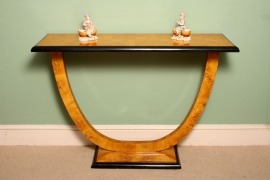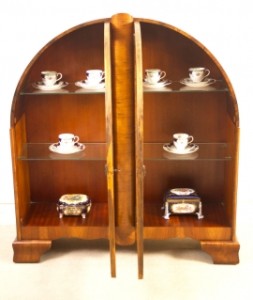Art Deco Furniture – Stylish, Sensual and Very Collectable
Futuristic, geometric and modern –Art Deco furniture offers a radical alternative to collecting heavier, more ornate and intrinsically historical styles and periods of antique furniture
Optimistic and modern – art deco in the 1920s
Art Deco (sometimes simply called Deco) was born in the 1920s in a period of optimism after the end of World War One. The term was first used by the hugely influential French architect Le Corbusier and the style followed on from the Arts Nouveau period which was characterised by curves and ornate organic motifs. In contrast Art Deco focused on simple geometric shapes such as squares and triangles and embraced technology, reflecting the optimistic view of the age that the machine age would liberate mankind from war and poverty. Much Art Deco work from furniture to architecture used rich colours and lavish ornamentation conveying a sense of exuberance, glamour and luxury.
The Art Deco style achieved worldwide popularity after the Exposition Internationale des Arts Décoratifs et Industriels Modernes held in Paris in 1925. From its very French origins Art Deco became an international movement and its legacy is particularly strong in relation to iconic landmark buildings which today are much loved examples of Art Deco architecture.
These include The Chrysler Building in New York; the famous Art Deco hotels of Miami; The Hoover building in West London, The original Arsenal Stadium in Highbury and several London Underground stations; The Bacardi Building in Havana (Cuba in particular retains a great deal of Art Deco architecture); The largest Art Deco quarter outside of Miami is in Mumbai and there are similar impressive areas in Perth and Casablanca. Art Deco was a truly international phenomenon which made a lasting global impression.
As the optimism of the 1920s gave way to the Great Depression, the rise of Fascism and eventually the Second World War, the popularity of sumptuous Art Deco gave way to the colder more austere styles of minimalism and post modernism. However today along with the much loved architectural styles described above there is great interest in Art Deco furniture and a strong and buoyant market in collectable Art Deco pieces.
Art Deco furniture – exotic woods, stunning shapes and shiny chrome
As technology and modernism was a key element in the Art Deco ethos Art Deco designers used very modern materials, including chrome, aluminium, plastic, marble, lacquer and even animal skin. Art Deco furniture was still predominantly made of wood but this core material was used in new innovative ways in contrast to the sometimes stiff, elaborate, historical styles of the past. 1920s French high end Art Deco furniture was manufactured from exotic woods such as ebony and burl walnut, maple and ash.
Later, as some of these woods became scarce, exotic veneers such as Brazilian jacaranda, zebra wood, palmwood, and calamander were used. Other veneers including sycamore, amboyna, mahogany and violet wood were also popular.
Inlays are central to many Art Deco furniture designs and may be of brass, ivory and mother of pearl. Pieces were finished with hides including shagreen, (a sharkskin often used for dressing table or desk tops) snakeskin, oriental silks and even pony skins. The optimistic focus on the future means that Art Deco furniture feels relaxed and welcoming with a focus on comfort and style. The Art Deco philosophy believed strongly in the concept that form should follow function. The idea of modular design first came to the fore with Art Deco furniture – different pieces could be used together or separately in a variety of flexible ways according to the owners’ needs and wants.
Collectable Art Deco furniture designer/makers include –
France
Jacques Emile Ruhlmann, Paul Follot and the Sue et Mare partnership. Pierre Chareau, Pierre Legrain ,Armand Albert Rateau and Jean Michel-Frank all represent the early, highly luxurious and glamourous Parisian origins of Art Deco furniture.
Many interesting pieces were produced by Eileen Gray, a reclusive Irish woman who became established in Paris. She sold superb lacquered wood and tubular pieces from her shop Galerie Jean Desert.
The UK
In Britain the early pioneers of Art Deco furniture included Gordon Russell who combined the feel of the early Arts and Crafts movement with Parisian Art Deco and Betty Joel whose feminine Hollywood inspired furniture attracted elite clients including the British Royal family and top hotels like the Savoy. Other British makers included the Epstein Brothers and Ray Hille who used fabulous walnut and veneers.
The USA
By the early 1930s Art Deco furniture had become popular in the USA. Donald Deskey, who designed the interior of Radio City Hall, created more affordable and accessible, modernist, streamlined furniture designs for department stores. Paul Frankl designed affordable furniture in Manhattan inspired by the rising skyline of New York. His modular pieces in black and red, steel and chrome sold to the new high rise apartment dwelling trend setters. His work is now highly sought after and collectable.
Scandinavia
Art Deco furniture is also very much associated with Scandinavian designers such as the Finnish husband and wife team of Alvar Aalto and Aino Marsion famous for their beautiful pale curved laminated Birch Art Deco furniture.
Regent Antiques are pleased to offer an extensive range of practical and collectable Art Deco furniture and other Art Deco collectable items – please contact us for further details.




